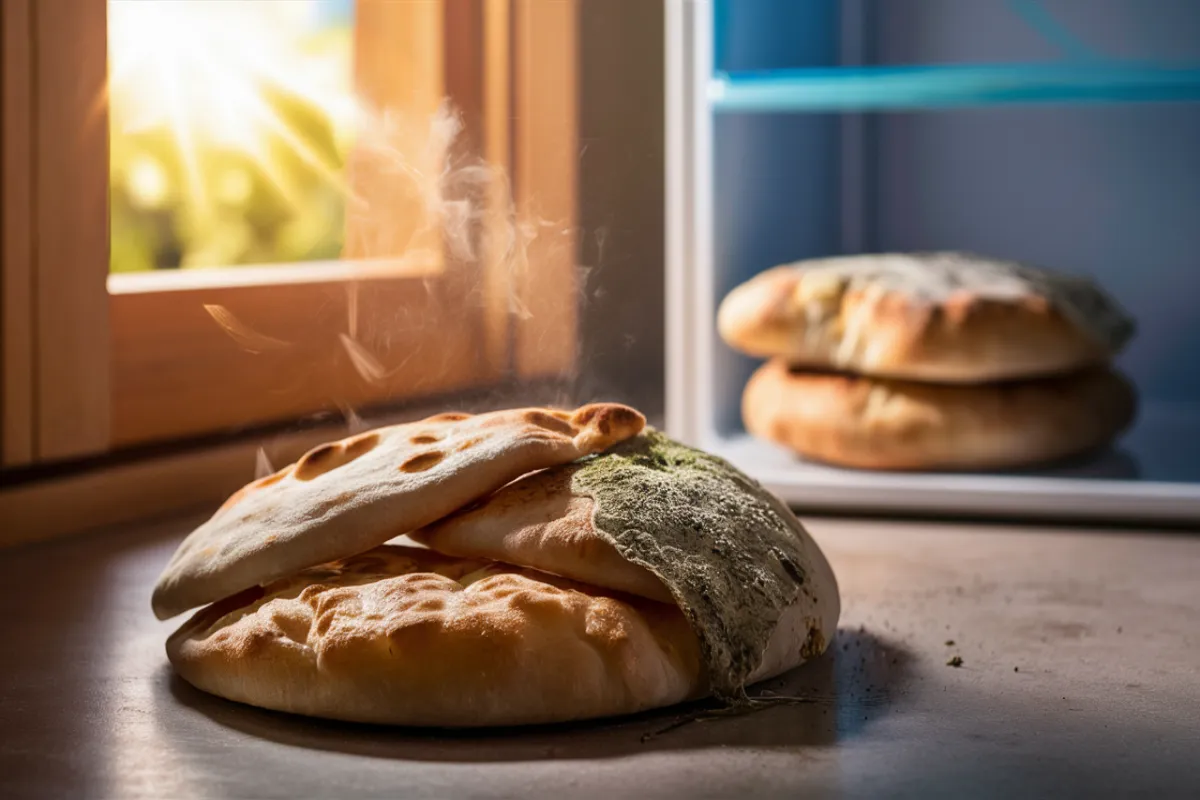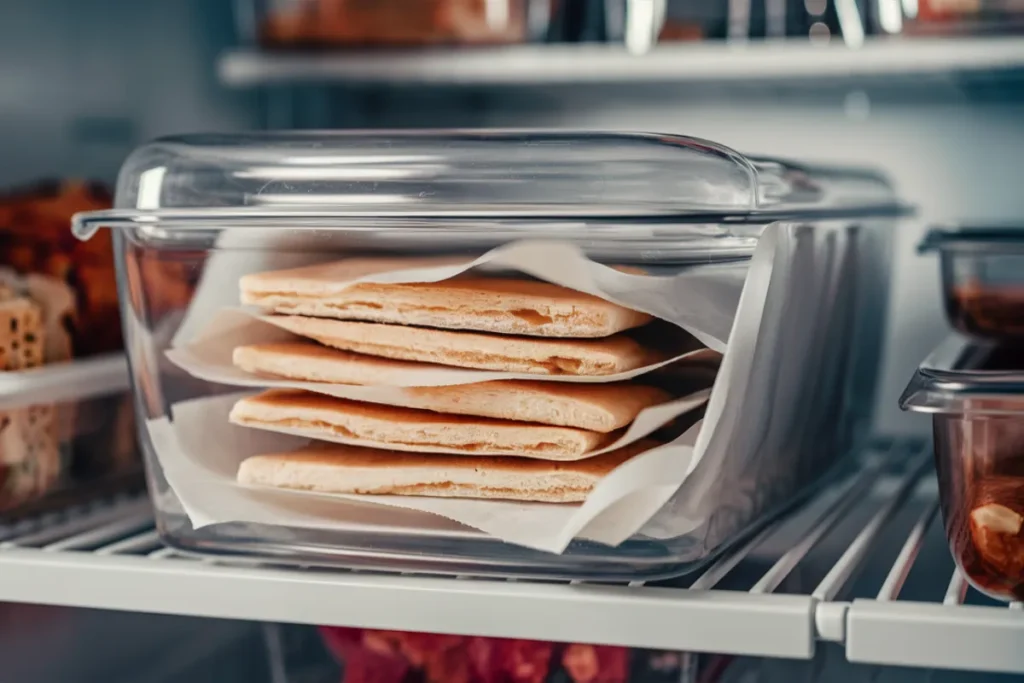Flatbread has become an essential part of many meals. Whether used as a pizza base, a wrap, or on its own, it is versatile and delicious. But a common question often arises: Does flatbread go in the fridge? In this comprehensive guide, I will answer this question while exploring the best ways to store flatbread to maintain its freshness and texture.
1. Does Flatbread Go in the Fridge for Short-Term Storage?
1.1 Short-Term Storage in the Fridge
If you plan to use your flatbread within a few days, the fridge is a great option. Flatbread goes in the fridge to help retain its freshness for up to 3-4 days. Keeping it refrigerated helps prevent mold growth, especially in humid environments.
However, you should take certain precautions when storing flatbread in the fridge. First, wrap the flatbread tightly in plastic wrap or aluminum foil. This keeps moisture from entering, preventing the bread from becoming soggy. You can also store it in an airtight container to maintain freshness.
Tip:
If you’re storing flatbread in the fridge for short-term use, reheat it in the oven or stovetop to restore its texture and warmth.
1.2 Does Flatbread Go in the Fridge Immediately After Baking?
You may wonder, does flatbread go in the fridge right after baking? The answer is no. After baking, let the flatbread cool to room temperature first. Placing hot flatbread in the fridge traps moisture inside, which can make it soggy and affect the texture. Once cooled, store it properly for later use.
Allowing flatbread to cool ensures it maintains its intended texture when reheated. Always remember that flatbread’s flavor and texture are best preserved when stored under the right conditions.
2. Long-Term Storage Options for Flatbread

2.1 Does Flatbread Go in the Freezer for Long-Term Storage?
If you have extra flatbread and don’t plan to use it within a few days, the freezer is an excellent long-term storage solution. Freezing flatbread extends its shelf life for up to 3 months without compromising its texture. So, if you ask, does flatbread go in the fridge or freezer for longer storage, the freezer is the way to go.
To freeze flatbread, first, wrap each piece individually in plastic wrap or aluminum foil. Afterward, place the wrapped flatbreads in a freezer-safe bag or container. This method prevents freezer burn and ensures that the flatbread remains fresh until you’re ready to use it.
Tip:
When you’re ready to eat frozen flatbread, thaw it in the fridge or reheat it directly from frozen in the oven or toaster.
2.2 Should You Refrigerate Store-Bought Flatbread?
Store-bought flatbread often comes with preservatives that extend its shelf life at room temperature. However, once you open the packaging, you should store the remaining flatbread in the fridge. This ensures that the flatbread stays fresh and mold-free for up to a week.
If you’re unsure about the storage instructions, check the label. Generally, the answer to the question, does flatbread go in the fridge after opening, depends on the product’s ingredients and packaging.
3. What Happens If You Don’t Refrigerate Flatbread?
3.1 Mold and Staleness Risks

Flatbread contains natural ingredients that can spoil over time. If left at room temperature for too long, it becomes vulnerable to mold growth, especially in warmer climates. The risk of mold increases if you leave flatbread uncovered, as moisture from the air accelerates the process.
If you live in a humid environment, flatbread goes in the fridge to avoid spoilage. Otherwise, storing it at room temperature may be acceptable if you plan to use it within a day or two. However, once mold starts to grow, the flatbread is no longer safe to eat.
3.2 Does Flatbread Lose Its Freshness Outside the Fridge?
When you leave flatbread outside the fridge for an extended period, it becomes stale. Flatbread left uncovered quickly loses moisture, making it dry and hard. To avoid this, store flatbread in a cool, dry place if you don’t plan to refrigerate it.
If your flatbread has become slightly stale, you can try reheating it in the oven to regain some of its softness. However, the best way to maintain freshness is to store it properly in the fridge.
4. Reheating Refrigerated Flatbread
4.1 How to Reheat Flatbread from the Fridge
If you’re wondering how to reheat refrigerated flatbread without making it soggy, several methods can help you. One of the best ways to reheat flatbread from the fridge is by using an oven or toaster oven. Preheat the oven to 350°F and place the flatbread on a baking sheet. Heat for 5-7 minutes until the bread is warm and slightly crispy.
Another effective method is reheating flatbread on the stovetop. Use a non-stick skillet over medium heat, flipping the flatbread after 1-2 minutes on each side. This method allows you to enjoy crispy and warm flatbread, just like when it was freshly baked.
Tip:
Avoid using the microwave for reheating, as it can make flatbread too soft or soggy. Stick to the oven or stovetop for the best results.
4.2 Can You Reheat Flatbread Straight from the Freezer?
Yes, you can reheat flatbread directly from the freezer without thawing it first. This saves time and still delivers excellent results. Simply place the frozen flatbread in the oven at 375°F for about 10 minutes. The heat will thaw and warm the flatbread at the same time.
For an extra crispy result, finish reheating frozen flatbread on the stovetop after using the oven. This ensures the bread regains its crispy exterior while remaining soft inside.
5. How to Keep Flatbread Fresh in the Fridge
5.1 Proper Wrapping for Refrigeration

If flatbread goes in the fridge, proper wrapping is key to keeping it fresh. Always wrap flatbread tightly in plastic wrap or foil to prevent moisture from entering. For extra protection, store the wrapped flatbread in an airtight container. This prevents the bread from absorbing odors from the fridge while retaining its original texture.
Proper wrapping helps extend the flatbread’s shelf life in the fridge, ensuring it remains as delicious as when it was freshly baked.
5.2 Airtight Containers for Better Storage

Using airtight containers is another effective way to store flatbread in the fridge. These containers keep the flatbread from drying out and help maintain its softness. If you plan to store flatbread in the fridge for several days, an airtight container offers the best protection against spoilage and staleness.
Learn how cybersecurity offers vital protection for modern businesses
Tip:
For large quantities of flatbread, consider stacking them between sheets of parchment paper before placing them in the container. This prevents the flatbreads from sticking together.
6. Can You Store Homemade Flatbread in the Fridge?
6.1 Storing Homemade Flatbread in the Fridge
Homemade flatbread should be stored in the fridge if you don’t plan to eat it within a day. Since homemade flatbread typically lacks preservatives, it is more prone to spoilage. After baking, let the flatbread cool completely before wrapping it tightly in plastic wrap or foil. Then, store it in the fridge for up to 4 days.
6.2 Reheating Homemade Flatbread from the Fridge
To reheat homemade flatbread, follow the same method as store-bought flatbread. Use the oven or stovetop for the best results. Avoid the microwave, as it tends to make homemade flatbread too soft. For added flavor, brush olive oil or butter on the flatbread before reheating.
7. Should Flatbread Dough Go in the Fridge?
7.1 Storing Flatbread Dough for Later Use

If you’ve prepared flatbread dough and want to store it for later, it’s best to refrigerate the dough. After kneading, cover the dough tightly with plastic wrap or place it in an airtight container. Flatbread dough can be stored in the fridge for up to 2 days before baking.
Refrigerating the dough also allows for better flavor development, as it gives the yeast time to work. When you’re ready to use the dough, let it come to room temperature before shaping and baking.
7.2 Freezing Flatbread Dough
For long-term storage, you can freeze flatbread dough. Shape the dough into a ball and wrap it tightly in plastic wrap, followed by aluminum foil. Store the wrapped dough in a freezer-safe bag for up to 3 months. Thaw the dough in the fridge overnight before baking.
8. Does Flatbread Go in the Fridge After Toppings Are Added?
8.1 Storing Flatbread with Toppings
If you’ve made flatbread with toppings, such as cheese, meats, or vegetables, it must go in the fridge. Flatbread with perishable toppings should always be refrigerated to prevent the ingredients from spoiling.
Wrap the flatbread tightly in plastic wrap or store it in an airtight container. This helps keep the toppings fresh while maintaining the flatbread’s texture. When reheating, use the oven to ensure the toppings warm up evenly without becoming soggy.
Conclusion
So, does flatbread go in the fridge? Yes, it does, especially if you want to keep it fresh for longer. The fridge is ideal for short-term storage, while the freezer works well for long-term use. Whether you’re storing store-bought or homemade flatbread, following proper storage techniques will ensure it remains fresh, soft, and delicious.
By understanding how to store and reheat flatbread, you can enjoy this versatile bread any time you like. So the next time you ask yourself, does flatbread go in the fridge, remember that it’s an excellent option for maintaining its quality and flavor.
Leave a Reply